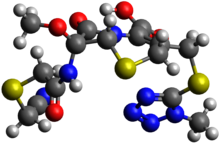 | |
 | |
| Clinical data | |
|---|---|
| AHFS/Drugs.com | International Drug Names |
| MedlinePlus | a601206 |
| ATC code | |
| Identifiers | |
| |
| CAS Number | |
| PubChem CID | |
| DrugBank | |
| ChemSpider | |
| UNII | |
| KEGG | |
| ChEBI | |
| ChEMBL | |
| CompTox Dashboard (EPA) | |
| ECHA InfoCard | 100.054.877 |
| Chemical and physical data | |
| Formula | C15H17N7O5S3 |
| Molar mass | 471.53 g·mol−1 |
| 3D model (JSmol) | |
| |
| |
| | |
Cefmetazole is a cephamycin antibiotic, usually grouped with the second-generation cephalosporins.
Adverse effects
[edit]The chemical structure of cefmetazole, like that of several other cephalosporins, contains an N-methylthiotetrazole (NMTT or 1-MTT) side chain. As the antibiotic is broken down in the body, it releases free NMTT, which can cause hypoprothrombinemia (likely due to inhibition of the enzyme vitamin K epoxide reductase) and a reaction with ethanol similar to that produced by disulfiram, due to inhibition of aldehyde dehydrogenase.[1]
Spectrum of bacterial susceptibility
[edit]Cefmetazole is a broad-spectrum cephalosporin antimicrobial and has been effective in treating bacteria responsible for causing urinary tract and skin infections. [citation needed]The following represents MIC susceptibility data for a few medically significant microorganisms.
- Bacteroides fragilis: 0.06 - >256 μg/ml
- Clostridium difficile: 8 - >128 μg/ml
- Staphylococcus aureus: 0.5 - 256 μg/ml (includes MRSA)[2]
References
[edit]- ^ Stork CM (2006). "Antibiotics, antifungals, and antivirals". In Nelson LH, Flomenbaum N, Goldfrank LR, Hoffman RL, Howland MD, Lewin NA (eds.). Goldfrank's toxicologic emergencies. New York: McGraw-Hill. p. 847. ISBN 0-07-143763-0. Retrieved 2009-07-03.
- ^ "Cefmetazole, free acid Susceptibility and Concentration Range (μg/ml) Minimum Inhibitory Concentration (MIC) Data" (PDF). The Antimicrobial Index. TOKU-E. 6 January 2020.
Well, that’s interesting to know that Psilotum nudum are known as whisk ferns. Psilotum nudum is the commoner species of the two. While the P. flaccidum is a rare species and is found in the tropical islands. Both the species are usually epiphytic in habit and grow upon tree ferns. These species may also be terrestrial and grow in humus or in the crevices of the rocks.
View the detailed Guide of Psilotum nudum: Detailed Study Of Psilotum Nudum (Whisk Fern), Classification, Anatomy, Reproduction